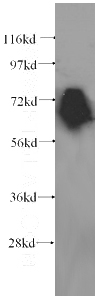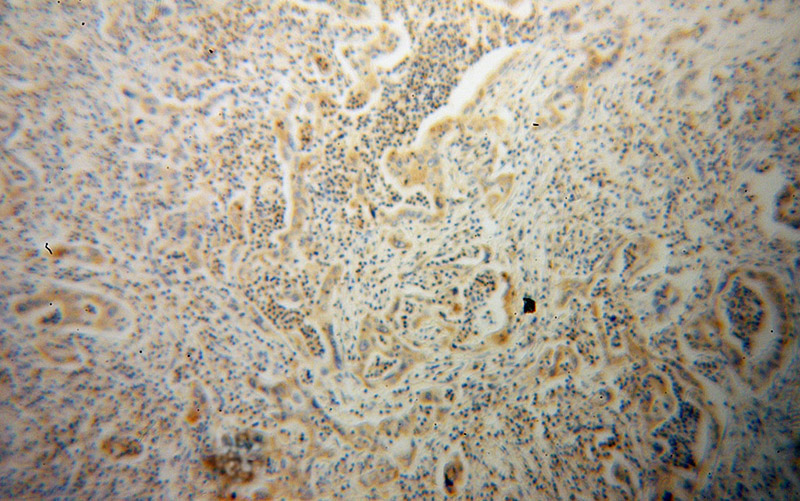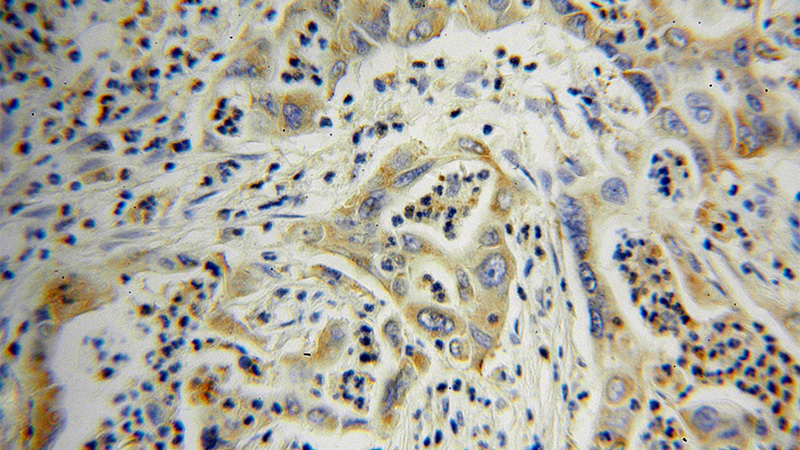-
Product Name
KEAP1 antibody
- Documents
-
Description
KEAP1 Mouse Monoclonal antibody. Positive WB detected in HeLa cells, Jurkat cells. Positive IHC detected in human pancreas cancer tissue, human endometrial cancer tissue, human kidney tissue, human skeletal muscle tissue. Observed molecular weight by Western-blot: 68+66 kDa
-
Tested applications
ELISA, IHC, WB
-
Species reactivity
Human, Rat; other species not tested.
-
Alternative names
Cytosolic inhibitor of Nrf2 antibody; INrf2 antibody; KEAP1 antibody; Kelch like protein 19 antibody; KIAA0132 antibody; KLHL19 antibody
-
Isotype
Mouse IgA
-
Preparation
This antibody was obtained by immunization of KEAP1 recombinant protein (Accession Number: XM_011528452). Purification method: Caprylic acid/ammonium sulfate precipitation.
-
Clonality
Monoclonal
-
Formulation
PBS with 0.1% sodium azide and 50% glycerol pH 7.3.
-
Storage instructions
Store at -20℃. DO NOT ALIQUOT
-
Applications
Recommended Dilution:
WB: 1:200-1:2000
IHC: 1:20-1:200
-
Validations

HeLa cells were subjected to SDS PAGE followed by western blot with Catalog No:107361(KEAP1 antibody) at dilution of 1:500

Immunohistochemical of paraffin-embedded human pancreas cancer using Catalog No:107361(KEAP1 antibody) at dilution of 1:100 (under 10x lens)

Immunohistochemical of paraffin-embedded human pancreas cancer using Catalog No:107361(KEAP1 antibody) at dilution of 1:100 (under 40x lens)
-
Background
KEAP1, also named as INRF2, KIAA0132 and KLHL19, is part of a multiprotein complex that contains the CUL3-Roc1 ubiquitin ligase, which can ubiquitinate the N-terminal domain of NRF2. Two molecules of KEAP1 bind to two distinct sites in the N-terminal region of NRF2, the ETGE and DLG sites, which affect the KEAP1-NRF2 interaction and/or its physiological consequences. KEAP1 retains NFE2L2/NRF2 in the cytosol. It functions as substrate adapter protein for the E3 ubiquitin ligase complex formed by CUL3 and RBX1. It also retains BPTF in the cytosol. This antibody is a mouse monoclonal antibody raised against residues near the C terminus of human KEAP1. Read more about this antibody on the blog:http://blog.ptglab.com/index.php/nsclc-research-anti-keap1-antibody-helps-uncover-targets-biomarker-potential/
-
References
- Soares MA, Cohen OD, Low YC. Restoration of Nrf2 Signaling Normalizes the Regenerative Niche. Diabetes. 65(3):633-46. 2016.
- Chandiramani N, Wang X, Margeta M. Molecular basis for vulnerability to mitochondrial and oxidative stress in a neuroendocrine CRI-G1 cell line. PloS one. 6(1):e14485. 2011.
- Huang CF, Zhang L, Ma SR. Clinical significance of Keap1 and Nrf2 in oral squamous cell carcinoma. PloS one. 8(12):e83479. 2013.
- Lee DF, Kuo HP, Liu M. KEAP1 E3 ligase-mediated downregulation of NF-kappaB signaling by targeting IKKbeta. Molecular cell. 36(1):131-40. 2009.
- Zhao F, Li K, Zhao L. Effect of Nrf2 on rat ovarian tissues against atrazine-induced anti-oxidative response. International journal of clinical and experimental pathology. 7(6):2780-9. 2014.
- Choi CY, Kim JY, Wee SY. Expression of nuclear factor erythroid 2 protein in malignant cutaneous tumors. Archives of plastic surgery. 41(6):654-60. 2014.
- Lee YJ, Kwon SB, An JM. Increased protein oxidation and decreased expression of nuclear factor E2-related factor 2 protein in skin tissue of patients with diabetes. Clinical and experimental dermatology. 40(2):192-200. 2015.
- Jimenez-Blasco D, Santofimia-Castaño P, Gonzalez A, Almeida A, Bolaños JP. Astrocyte NMDA receptors' activity sustains neuronal survival through a Cdk5-Nrf2 pathway. Cell death and differentiation. 22(11):1877-89. 2015.
Related Products / Services
Please note: All products are "FOR RESEARCH USE ONLY AND ARE NOT INTENDED FOR DIAGNOSTIC OR THERAPEUTIC USE"
